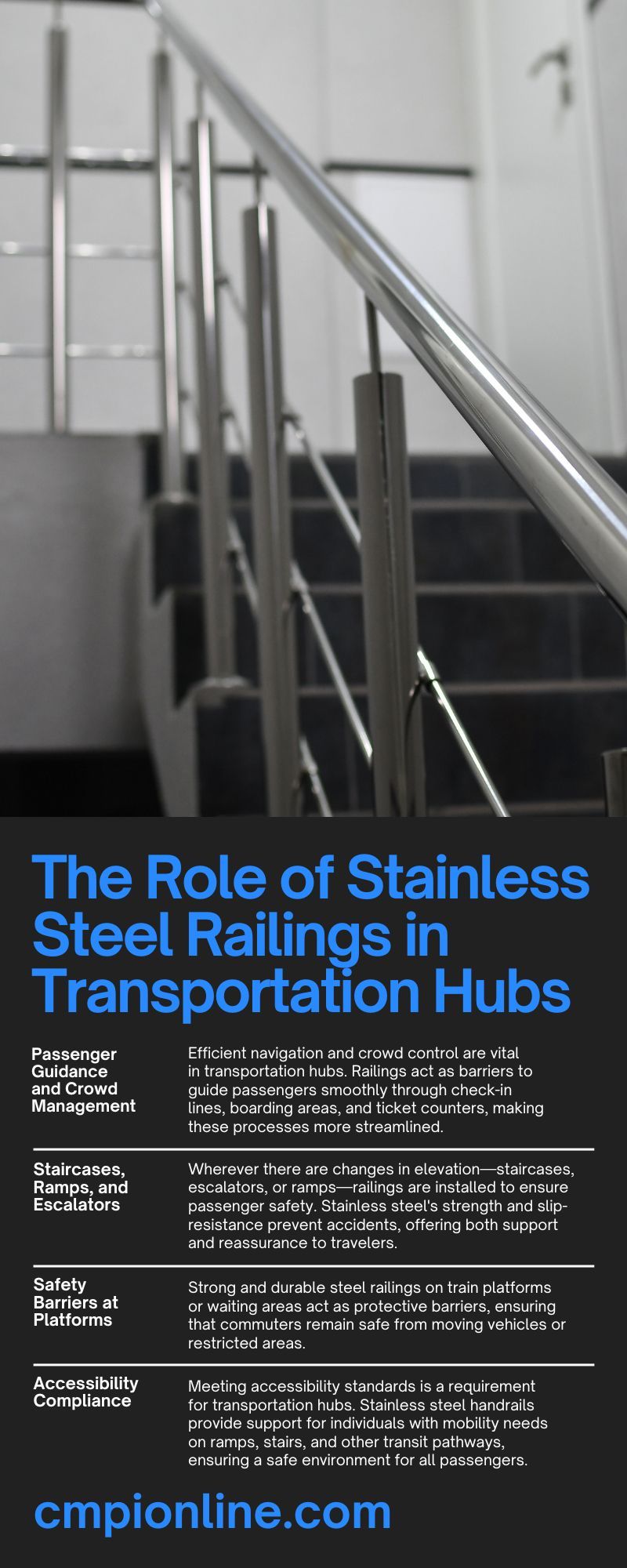The Role of Stainless Steel Railings in Transportation Hubs

Modern transportation hubs such as airports, train stations, and bus terminals face constant wear and tear from heavy foot traffic. Stainless steel railings are an excellent choice for such environments because of their unparalleled strength and resilience. These railings provide functionality, reinforce safety, and contribute to the aesthetic appeal of the infrastructure.
Keep reading to learn more about the role of stainless steel railings in transportation hubs.
Safety and Security Benefits of Steel Railings
Safety is paramount in spaces where there is a constant influx of people, including children, older travelers, and individuals with disabilities. Stainless steel railings contribute significantly to maintaining a safe environment for everyone. For instance, railings support people ascending or descending stairs, escalators, or wheelchair ramps. Their ergonomic designs ensure comfort while offering a firm grip.
Maintaining clear pathways is equally important, as a confusing layout could lead to people wandering into dangerous or off-limit areas. Well-placed steel railings help guide crowds, preventing bottlenecks and aiding smoother movement through busy terminal areas. These railings are especially beneficial for managing passenger flow during peak travel times.
Stainless steel railings offer excellent strength and stability, making them a reliable barrier against potential accidents. This feature is necessary in high-security settings such as airports.
Stainless steel railings also often meet strict safety codes and accessibility standards, such as the Americans with Disabilities Act (ADA). Features such as rounded edges, specific handrail diameters, and proper installation heights ensure the railings are useful for everyone.
Aesthetic Appeal and Design Versatility
While functionality is crucial, design is equally important in transportation hubs. These spaces are gateways that create first impressions for visitors. A poorly designed or unwelcoming hub could deter visitors from returning. Stainless steel railings offer a sleek, contemporary look that enhances the architectural appeal of any space.
It's possible to shape stainless steel into various designs, from simple handrails to intricate balustrades. The material's flexibility allows architects to create designs that align with the overall aesthetics of the hub while maintaining its functional role.
Stainless steel railings are available in different finishes, such as polished, brushed, or satin, providing options to suit every aesthetic. For instance, a high-gloss finish might be ideal for a modern airport, while a matte finish could enhance the rustic appeal of a historic train station.
Stainless steel railings often pair seamlessly with other materials such as glass or wood. For example, combining stainless steel with tempered glass panels can create an open, airy look while maintaining safety.
Physical Advantages of Stainless Steel Railings
Stainless steel railings have physical properties that align perfectly with the transportation industry’s needs.
Resistance to Corrosion
Stainless steel contains chromium, which forms a passive chromium oxide layer on its surface. This protective barrier enhances corrosion resistance, ensuring the metal remains unaffected by the weather, humidity, and accidental spills of corrosive substances. Corrosion resistance is particularly valuable for railings at outdoor bus terminals or open train platforms.
Longevity
Unlike materials that quickly degrade or require frequent replacement, stainless steel can last for decades with minimal upkeep. This longevity makes stainless steel cost-effective for large spaces.
Impact Resistance
Stainless steel railings are powerful enough to handle significant pressure and impact without sustaining harm from luggage bumping into the railings or heavy crowds leaning against them. If an accident does occur, stainless steel can withstand much of the damage while keeping the blocked-off area secure.
Minimal Maintenance Required
Transportation hubs can sometimes be short-staffed with maintenance workers. Any material involved in a railing’s construction must be simple to clean, making stainless steel an obvious choice. Its smooth surface resists dirt and smudges, making it easy to maintain. A quick wipe with mild soap and water keeps these railings polished and professional. Stainless steel is also resistant to scratches and dents and can maintain its appearance even in high-traffic areas.
Sustainability of Stainless Steel
Sustainability is a growing concern in architecture and infrastructure development, and stainless steel is a material that aligns with eco-conscious goals. It's recyclable, and most stainless steel railings contain a significant percentage of recycled material. In this way, using stainless steel helps reduce waste and contributes to environmental conservation goals.
Even the production of stainless steel has become more energy-efficient over the years. Its long lifespan means it consumes fewer resources over time, reducing its environmental footprint. These railings can last years and still shine as if they're brand-new. Stainless steel's durability and resistance to corrosion also mean there's no need for frequent chemical treatments or coating, further limiting its environmental impact.
Applications Across Transportation Hubs
Stainless steel railings serve numerous purposes within transportation hubs, optimizing both function and flow.
Passenger Guidance and Crowd Management
Efficient navigation and crowd control are vital in transportation hubs. Railings act as barriers to guide passengers smoothly through check-in lines, boarding areas, and ticket counters, making these processes more streamlined.
Staircases, Ramps, and Escalators
Wherever there are changes in elevation—staircases, escalators, or ramps—railings are installed to ensure passenger safety. Stainless steel's strength and slip-resistance prevent accidents, offering both support and reassurance to travelers.
Safety Barriers at Platforms
Strong and durable steel railings on train platforms or waiting areas act as protective barriers, ensuring that commuters remain safe from moving vehicles or restricted areas.
Accessibility Compliance
Meeting accessibility standards is a requirement for transportation hubs. Stainless steel handrails provide support for individuals with mobility needs on ramps, stairs, and other transit pathways, ensuring a safe environment for all passengers.
Turn to CMPI for Your Stainless Steel Railings
Now that you know the important role of stainless steel railings in transportation hubs, choosing the right manufacturer is the next step.
At CMPI, we specialize in high-quality stainless steel handrail systems. With years of custom stainless steel fabrication expertise, we can ensure every product meets your exact specifications. From material selection to final installation, our processes guarantee precision, durability, and visual appeal. Whether you're constructing a new airport terminal or upgrading an existing train station, CMPI has the experience and resources to bring your vision to life.




